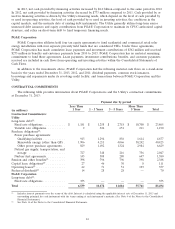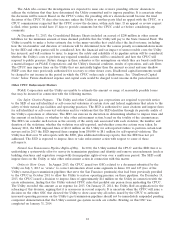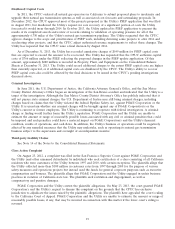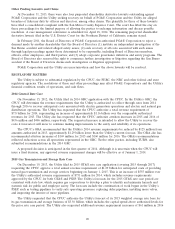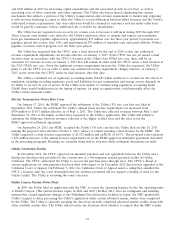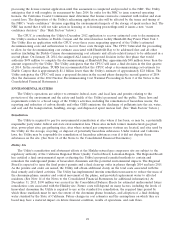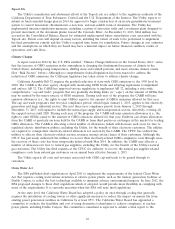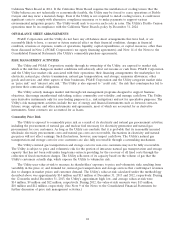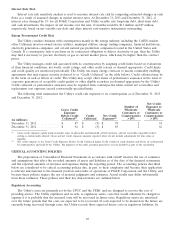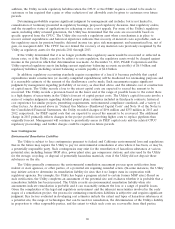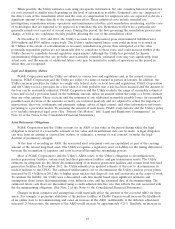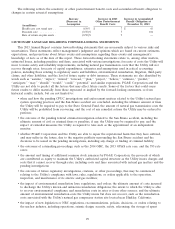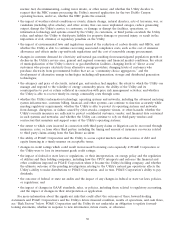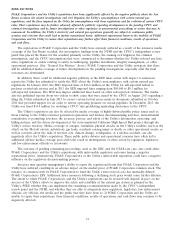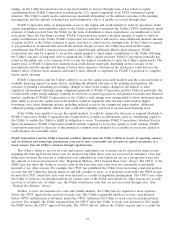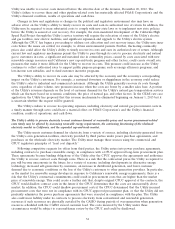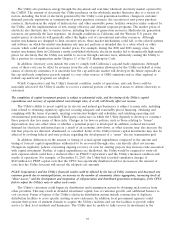PG&E 2013 Annual Report Download - page 32
Download and view the complete annual report
Please find page 32 of the 2013 PG&E annual report below. You can navigate through the pages in the report by either clicking on the pages listed below, or by using the keyword search tool below to find specific information within the annual report.addition, the Utility records regulatory liabilities when the CPUC or the FERC requires a refund to be made to
customers or has required that a gain or other reduction of net allowable costs be given to customers over future
periods.
Determining probability requires significant judgment by management and includes, but is not limited to,
consideration of testimony presented in regulatory hearings, proposed regulatory decisions, final regulatory orders,
and the strength or status of applications for rehearing or state court appeals. For some of the Utility’s regulatory
assets, including utility retained generation, the Utility has determined that the costs are recoverable based on
specific approval from the CPUC. The Utility also records a regulatory asset when a mechanism is in place to
recover current expenditures and historical experience indicates that recovery of incurred costs is probable, such as
the regulatory assets for pension benefits; deferred income tax; price risk management; and unamortized loss, net of
gain, on reacquired debt. The CPUC has not denied the recovery of any material costs previously recognized by the
Utility as regulatory assets for the periods 2011 through 2013.
If the Utility determined that it is no longer probable that regulatory assets would be recovered or reflected in
future rates, or if the Utility ceased to be subject to rate regulation, the regulatory assets would be charged against
income in the period in which that determination was made. At December 31, 2013, PG&E Corporation and the
Utility reported regulatory assets (including current regulatory balancing accounts receivable) of $6.5 billion and
regulatory liabilities (including current balancing accounts payable) of $6.8 billion.
In addition, regulatory accounting standards require recognition of a loss if it becomes probable that capital
expenditures under construction (or recently completed expenditures) will be disallowed for ratemaking purposes and
if a reasonable estimate of the amount of the disallowance can be made. Such assessments require significant
judgment by management regarding probability of recovery, as described above, and the ultimate cost of construction
of capital assets. The Utility records a loss to the extent capital costs are expected to exceed the amount to be
recovered. The Utility records a provision based on the lower end of the range of possible losses to the extent there
is a high degree of uncertainty in the Utility’s forecast of capital project costs. The Utility’s capital forecasts involve a
series of complex judgments regarding detailed project plans, estimates included in third-party contracts, historical
cost experience for similar projects, permitting requirements, environmental compliance standards, and a variety of
other factors. As discussed above in ‘‘Natural Gas Matters—Disallowed Capital Costs’’ and Note 14 of the Notes to
the Consolidated Financial Statements, the Utility recorded charges of $196 million and $353 million in 2013 and
2012, respectively, for PSEP capital costs that are expected to exceed the amount to be recovered. The additional
charge in 2013 primarily reflects changes in the project portfolio involving higher costs to replace pipelines than
originally forecast. Management will continue to periodically assess its PSEP capital costs and the related CPUC
regulatory proceedings, and further charges could be required in future periods.
Loss Contingencies
Environmental Remediation Liabilities
The Utility is subject to loss contingencies pursuant to federal and California environmental laws and regulations
that in the future may require the Utility to pay for environmental remediation at sites where it has been, or may be,
a potentially responsible party. Such contingencies may exist for the remediation of hazardous substances at various
potential sites, including former MGP sites, power plant sites, gas compressor stations, and sites used by the Utility
for the storage, recycling, or disposal of potentially hazardous materials, even if the Utility did not deposit those
substances on the site.
The Utility generally commences the environmental remediation assessment process upon notification from
federal or state agencies, or other parties, of a potential site requiring remedial action. (In some instances, the Utility
may initiate action to determine its remediation liability for sites that it no longer owns in cooperation with
regulatory agencies. For example, the Utility has begun a program related to certain former MGP sites.) Based on
such notification, the Utility completes an assessment of the potential site and evaluates whether it is probable that a
remediation liability has been incurred. The Utility records an environmental remediation liability when site
assessments indicate remediation is probable and it can reasonably estimate the loss or a range of possible losses.
Given the complexities of the legal and regulatory environment and the inherent uncertainties involved in the early
stages of a remediation project, the process for estimating remediation liabilities is subjective and requires significant
judgment. Key factors evaluated in developing cost estimates include the extent and types of hazardous substances at
a potential site, the range of technologies that can be used for remediation, the determination of the Utility’s liability
in proportion to other responsible parties, and the extent to which such costs are recoverable from third parties.
26


